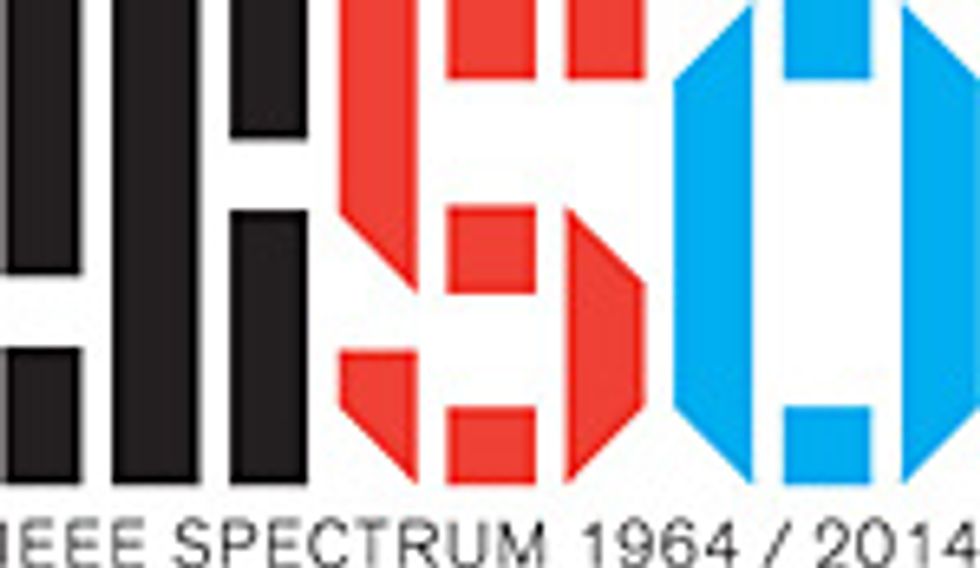Forecasting is harder but more interesting. For our 50th, we wanted an inspiring and compelling view of the world of tech 25 to 50 years from now, beyond the window of straightforward prediction. We liked the idea of making inferences, at least, about a future as distant from today as we are now from the year of the magazine’s founding.
We understood the risks. The Internet has made a minefield of the prediction business. It has long been accepted that any long-term forecasts you make about technology will probably be wrong and might very well be comical. That’s true even if you’re one of the world’s smartest and most acclaimed futurists, as was Isaac Asimov [above].
It so happens that this year is also the 50th anniversary of Asimov’s legendary essay outlining his vision of the world in 2014. Written on the occasion of the 1964 World’s Fair in Asimov’s beloved hometown of New York City, the piece is titled “Visit to the World’s Fair of 2014.”
And there’s mistake No. 1: There is no 2014 World’s Fair.
The anniversary of Asimov’s article has prompted a flurry of fatuous articles praising his prescience. But Asimov was actually rather off the mark. Of the two or three dozen predictions in the article, only four were indisputably accurate:
1. “Robots will be neither common nor very good in 2014.”
2. “By 2014, only unmanned ships will have landed on Mars.”
3. “As for television, wall screens will have replaced the ordinary set.”
4. “On earth…laser beams will have to be led through plastic pipes, to avoid material and atmospheric interference.”
The rest of the article is a mishmash of quaint yearnings and vague warnings. He thought by now we’d have a moon colony, underwater housing, moving sidewalks (what is it with “slidewalks”?), at least one fusion power plant, jet-powered hovercraft, home appliances powered by radioisotope “batteries,” and popular foodstuffs made from algae. He thought the entire area from Boston to Washington would be “a single city with a population of over 40 000 000.”
Asimov would have had to live to 94 to see whether his predictions panned out, but alas, he died in 1992 at age 72.
I’m not knocking Asimov. His envisioned future wasn’t so much a likely one as a desired one. If you looked at what was going on then and assumed it would continue—and had the optimism to believe that future advances would be applied aggressively to improve people’s lives or lift human civilization in whatever way possible—you would end up with something like Asimov’s vision.
And so we are coming clean at the outset of this issue: What we describe is a desired future. Like Asimov did, we started with broad areas of major technological ferment. We picked eight of them, including autonomous vehicles, wearable technology, and energy. We describe the state of the art today and likely near-term developments, and then sketch out a future in which things go well. In other words, a future in which a string of fortuitous events prevents a promising technology from being crushed by larger companies, stifled by the status quo, sidetracked by swifter or better-connected competitors, choked by regulations, undone by unforeseen problems, or shunted into oblivion by public misunderstanding, apathy, or ignorance.
A desired future may inevitably be an unlikely one. But it’s enlightening, maybe even beneficial, to think about it now, and to identify the kinds of things that would have to happen for that future to come to pass.
You might ask, Why not portray the world of 25 to 50 years from now as fiction? And, indeed, we’ve done that, too. We are delighted to include here an original story by Nancy Kress, “Someone to Watch Over Me.” It grippingly portrays how one very promising technology, implantable electronics, might be hideously misused. Kress’s is one of six sci-fi stories that we commissioned especially for our anniversary, from some of the top sci-fi writers working today. The full complement, including pieces by Greg Egan, Brenda Cooper, and Geoffrey Landis, will be collected in an e-book later this year.
In publishing this issue, we have to admit to an ulterior motive. After you’ve all forgotten about this edition, it will live on as a kind of gift to our successors at IEEE Spectrum in 2064, who will be charged with coming up with material for the 100th anniversary issue. It’s hard to imagine that the centennial edition of IEEE Spectrum will be available on printed paper. It’s even harder to imagine that the centennial issue of Sports Illustrated’s swimsuit edition won’t be available in 3-D virtual reality. But surely even in 1964 there were visionaries who believed that, at this point in the 21st century, we’d have moved beyond ink printed on pulped trees.
Had Asimov lived, he would probably have been disappointed by the fact that we have no permanent habitat on the moon, no nuclear-powered home appliances, and no significant human habitation under the sea. But that disappointment would undoubtedly dissolve in his delight at what we do have. That tally might start with
- a fast, easily accessible, planet-spanning data network;
- a pocket device that can shoot photos and video, store a huge music collection, and let its user converse or exchange text and images with another person anywhere on Earth;
- machines that can quickly and cheaply determine a person’s genome; and
- space telescopes that have discovered thousands of planets outside our solar system—and that will soon be able to determine the composition of a planet’s atmosphere as well.
And so, 50 years from now, staffers at IEEE Spectrum might very well smile indulgently at our hopes for shared autonomous cars, bioelectronic cures for disability, and a coherent strategy for space exploration. But they will surely have other things, every bit as marvelous. Probably more so.
I’ll have to live to be 102 to find out if they do. To my successor I offer this advice: Make your predictions bold. And set them so far in the future that you won’t live long enough to see whether they pan out.
This article originally appeared in print as “The Pitfalls of Prediction.”

